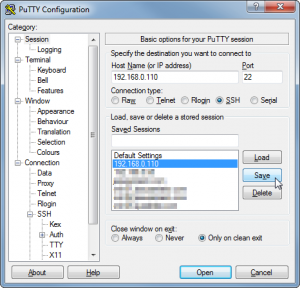
- #Putty ssh auto login full#
- #Putty ssh auto login android#
- #Putty ssh auto login password#
- #Putty ssh auto login download#
data/data//files/homeīin dev etc files home lib libexec tmp var Once connected via SSH, it is possible to change up a few directories to something which resembles a root directory, as shown in the Putty session below: $ pwd & ls
#Putty ssh auto login android#
backups Android EditedOnlinePhotos Music Ringtones
#Putty ssh auto login download#
PiMusicPlayer Alarms Download Movies Podcasts backup ANRSnap DCIM HuaweiSystem Pictures WhatsApp tencent photoShare Audiobooks Huawei Notifications Sounds NB there are alternatives to SSHelper such as SSHDroid, described here and here.įor some reason, the files on the Android (as might be seen by viewing the Android filesystem on Windows through a USB MTP connection) are stored in a folder in the home directory called "SDCard", as shown in the output from the Putty session below: $ ls In the configuration tab of SSHelper, find the server address (looks like an IP address), and the SSH server port number (EG 2222), and then connect using the following command: putty -ssh -P 2222 -pw admin SSHing into an Android phoneīy using the app SSHelper on an Android phone it is possible to connect to the phone using SSH via Putty on Windows, as described in this tutorial.

The -batch flag is used to automate the command such that it doesn't require user input.
#Putty ssh auto login password#
This can be done using the plink command (which is also installed by default along with Putty): plink -batch -pw password bash_command Instead of opening an SSH terminal, sometimes it is desirable to simply execute a single command on a remote Linux computer from a Windows computer (EG from a script on the Window computer which performs other commands).
#Putty ssh auto login full#
NB the bash command realpath can be used to get the full path to the file on the Linux computer (EG from an SSH terminal in the directory of the file).įiles can be transferred in the opposite direction from a Windows machine to a Linux machine with the syntax: pscp -pw password file1 file2 file3 recursively copy a directory, use the -r flag: pscp -r -pw password dir_name/ that if the target directory does not already exist on the remote machine, it can be created using the following command from the local machine (the -p flag is used to create all necessary parent directories) (see below for more information about plink): plink -ssh -batch -pw password mkdir -p path/to/parent/dir/dir_name/ A file with absolute path /path/to/file can be copied from a Linux machine to a Windows machine in the current directory with the command: pscp -pw password. PSCP is a tool which can be used to copy files between Linux and Windows computers (similar to scp which transfers files between Linux computers), and is installed by default along with Putty. This shortcut can also be added to the Start menu for even easier access, by right-clicking on the shortcut and selecting "Pin to Start".This shortcut can now be used to start up this SSH session automatically, without having to open PuTTY and enter the hostname, username and password every time.


If the same user on the same Linux machine is to be accessed repeatedly, this command can be automated in Windows by creating a shortcut as follows:

Given the username, hostname, and password of a Linux machine which is to be SSHed into, Putty can be automated from the command line as follows (assuming Putty is on the Windows path): putty -ssh -pw password Putty is a tool which can be used for various purposes, including communicating with a Linux computer using SSH (Secure SHell) from a Windows computer.


 0 kommentar(er)
0 kommentar(er)
